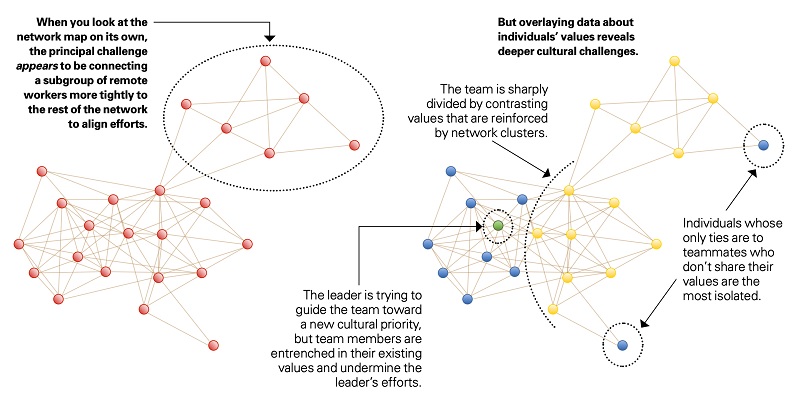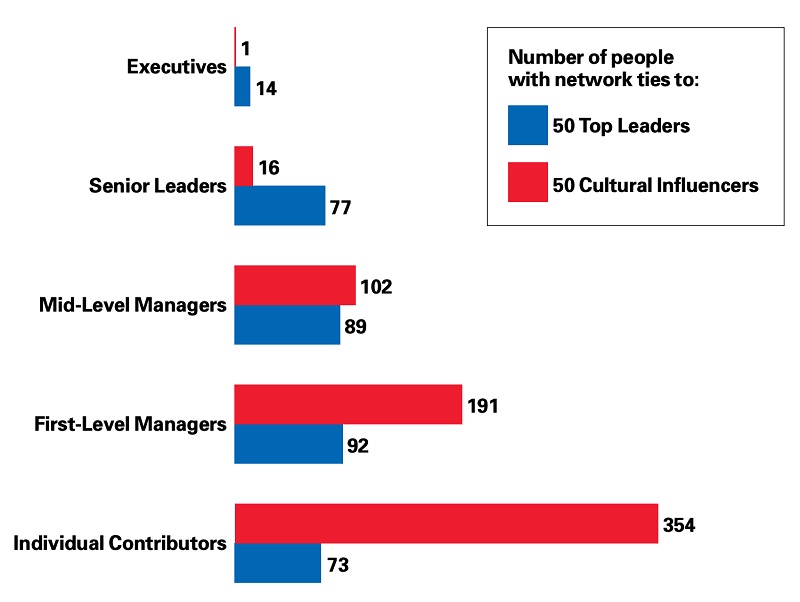Framework 120 Driving Change Through Informal Networks
Introduction
Work habits are harder to break as 'it's the way we do things around here' and there is needs to be understanding of which of the deeply held beliefs are good, desirable and appropriate.
"... Relationships can complicate matters further. When colleagues are embedded in informal networks with others who share and reinforce their values, they often become entrenched rather than open to new attitudes and behaviours..."
Peter Gray et al, 2021
However, networks, can be helpful in identifying and overcoming obstacles to cultural change and to finding unexpected supporters.
The traditional assessments of organisational culture tends to focus on finding commonality, eg
- use surveys to assess staffs' values, attitudes, norms and behaviour; then average the responses to gauge where the organisation as a whole stands
- conduct deep interviews and develop a 'typical employee'
These approaches can miss powerful insights where people differ.
Also, try to understand who is interacting with whom, both within groups and between groups, to get a better understanding of an organisational culture and ways to change it, eg you need to analyse patterns of collaboration. Thus combining survey data with network analysis is a good way to gain appropriate insights (see below diagram)
"...Mapping patterns of collaboration in an organisation provides the kind of X-ray view of its inner working. It shows, for example, where people are separated by silos in a network, who is isolated on the periphery, which individuals are opinion leaders, and which ones are uniquely situated to connect people and integrate different values. Once leaders know all that, they can pursue cultural change in a targeted manner..."
Peter Gray et al, 2021

This highlights the invisible challenges, eg individuals being anchored within their zones of comfort in a group, ie feeling safe, happy with the status quo and their perspectives, developing an 'us versus them' attitude to non-group members, etc. These invisible challenges need to be identified and addressed for change to be effective.
Developing this more nuance understanding will identify well-connected cultural outliers, ie influential people who have strong beliefs that could differ from those around them and/or the organisation. You need to get these people on side as their views are respected and staff listen to them, and also they could be identifying areas in the change process that need improving
Five ways to drive change through informal networks
1. Unearth the subcultures (in addition to organisational cultures as described by beliefs, values and behaviours, subgroups such as functions, divisions, geographies, etc can have their own culture which can be different from the organisational one
"...Culture is only partly influenced by formal organisational structures; it is also shaped and reinforced by subnetworks of employees who may represent one slice of a formal unit.....across many different units..."
Peter Gray et al, 2021)
2. Find your real cultural leaders (most senior managers see that as one of the key responsibilities to define and spread culture throughout organisation; this is driven from the top of the formal structure, ie hierarchical; however, informal influencers within the organisation need to be supporters of the change for it to be effective.
Most culture is learnt from informal conversation, ie what signals you should take seriously, what to care about, 'how we do things around here', who makse things happen, etc. The 'informal leaders' or 'network influencers' shape these conversations, especially for those staff at the lower levels of the organisation; while senior staff are connected better at the top end of the hierarchy (see diagram below))

3. Shine a light on hidden tensions (analyse network and cultural data to highlight any areas that have hidden tensions and find ways to manage them; some examples can include
- toxic misalignment where cultural influencers, who have very different sets of values, can interact negatively and in dysfunctional ways, like definitions of ethical and unethical behaviour, eg selling customer data to a third-party
- unresolved standoffs where cultural influencers have positive connections but disagree around fundamental cultural values, like which is the most important priority, people, processes and technology.
In these cases it is important to appeal to a higher, share value to help get agreement.
"...Network analytics can be used to identify where the influencers are on each side of a disagreement; they always distributed throughout the network and never in a single role, function, geography. Analytics can be also used to determine the nature of the influencers' interaction - positive, neutral, or negative. Leaders can then see and address dysfunctional relationships..."
Peter Gray et al, 2021)
4. Evoked positive emotions (need more than a rational approach to handle the emotional aspects; need to promote positive emotions to help people adopt desired cultural values; use 'soft skills' like active listening, conflict resolution, communications, etc
"...Learn how to engage people in realistic possibilities that capture their imagination and hearts...... how to help others see how their efforts contribute to an ambitious plan..."
Peter Gray et al, 2021)
Promoting negative emotions, like fear or resentment, can result in propagating unwanted cultural norms and/or stifling the spread of desired values.
Need to seek engagement rather than demand compliance; encourage accountable behaviour.)
5. Give adoption the time it needs (the time it takes to master new cultural norms behaviours can vary; it is depending on how tacit or complex the values are; senior staff must role model new behaviours, values, etc; reward and recognition system must support the new behaviours, etc.
(for more detail, see network mapping in this Knowledge Base)
